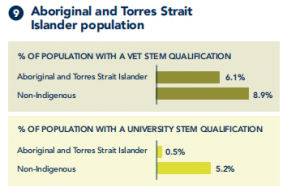Women and Aboriginal and Torres Strait Islander people made gains in Australia’s STEM workforce in the decade to 2016, but further major efforts are needed to achieve equality.
The 2020 Australia’s STEM Workforce Report reveals some progress in pursuing greater diversity in the science, technology, engineering and maths workforce, but confirms there is much more to do.
It also highlights the strong value of a STEM degree to students – with a larger share of STEM graduates in the highest income bracket in Australia than non-STEM graduates.
Science & Technology Australia Chief Executive Officer Misha Schubert said the data shows we still have a long way to go to reach equality in most STEM fields.
“Even with strong gender equity efforts over many years, just one in ten workers with a VET STEM qualification and one in three workers with a STEM degree are women,” she said.
“The data also shows that just one in 200 Aboriginal or Torres Strait Islander people of working age have a STEM degree – while one in 20 non-Indigenous working age people have a STEM degree.”
Aboriginal and Torres Strait Islander Mathematics Alliance president and Quandamooka man Professor Chris Matthews said much more needed to be done to boost the number of Indigenous Australians doing STEM study at university and VET.
“Aboriginal and Torres Strait Islander people are this continent’s first STEM knowledge makers and knowledge keepers, and we need to see more STEM places for Indigenous students,” he said.
Deadly Science founder and Kamilaroi man Corey Tutt said his ground-breaking program aimed to inspire Aboriginal and Torres Strait Islander students to pursue STEM study in school and beyond.
“Our kids are natural scientists – it’s in their blood. My aim with Deadly Science is to inspire a much greater number of our kids to study STEM at uni or TAFE.”
The STEM workforce report, published yesterday by Australia’s Chief Scientist Alan Finkel, shows slow and patchy – but hugely important – gains towards greater gender equality in STEM.
From 2006 to 2016, women remained just 9 per cent of the VET STEM qualified workforce. Women’s representation in the university STEM qualified workforce rose only slightly from 28% to 31%.
This was despite an extra 50,000 women entering the STEM workforce between 2011 and 2016.
Women are most acutely under-represented in engineering (15%), physics (20%) and astronomy (20%), and in maths and technology.
“The huge task of tackling this underrepresentation highlights a crucial role of initiatives such as our game-changing Superstars of STEM program to lift the profiles of women in STEM,” Ms Schubert said.
Of the broad STEM fields, the broad field of science was the only one close to gender parity- women were 49% of the workforce with a university qualification in science in 2016.
The report also highlights the challenges for mothers in STEM, with women in STEM more likely to be working part-time and juggling caring responsibilities with careers.
In Australia’s workforce of 11 million people, almost two million workers have a STEM qualification.
Around one in four of Australia’s VET STEM qualified workers were born overseas – and around one in two university qualified STEM workers were born overseas.
More than half of our STEM PhDs are from overseas, many coming here as international students.










